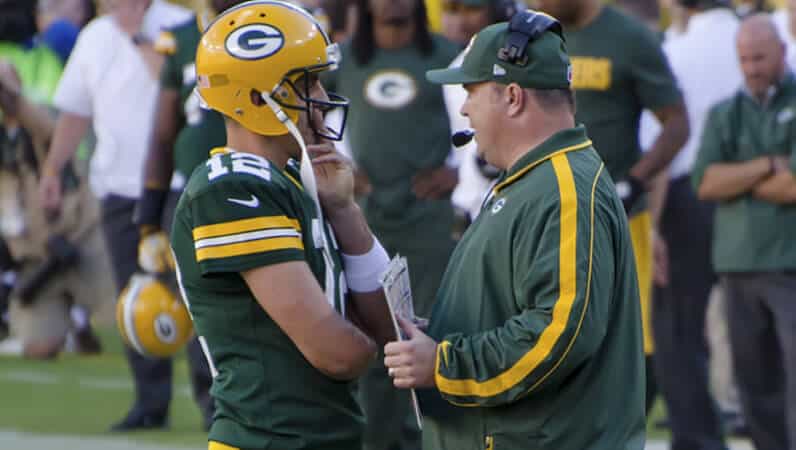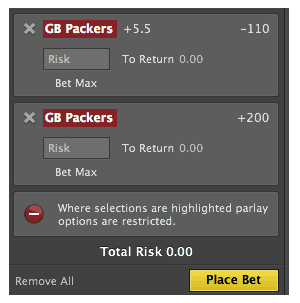
Just like NFL quarterbacks and coaches, parlay bets are more likely to win when they work together. (Photo credit: Mike Morbeck / Foter / CC BY-SA)
If you’ve played Proline, you know how difficult it is to win parlays.
Parlay betting is difficult because you generally have to combine several bets that have a 50/50 chance of winning, and get them all correct to cash your ticket.
But what if the picks you could make on your parlay bet weren’t really 50/50 propositions when they were combined together?
Welcome to the world of correlated parlays.
Correlated means that if one thing happens, another is very likely to happen.
So, correlated parlays means combining outcomes that are dependent on each other.
The simplest example is taking a team on the moneyline and also on the point spread. If a favourite covers the point spread, they must have also won on the moneyline. And if an underdog wins on the moneyline, they would have covered the point spread as well.
Can’t parlay moneyline with spread picks
This type of correlated parlay is so obvious, sportsbooks don’t allow it:
There are other, more subtle, ways to try to make a correlated parlay.
The most common example of a correlated parlay involves heavy favourites in college football.
Favourites and overs
In Week 1 of the 2014 NCAA football season, Oklahoma was a 37.5-point favourite over Louisiana Tech and the over/under was 51.5.
If Oklahoma was to cover the spread, the Sooners would have to score more than 37 points. Even if Louisiana Tech only scored 7 points, Oklahoma would have to score more than 44 points to cover.
Therefore, if Oklahoma was to cover, the game would be very likely to go over the total as well. Combining Oklahoma and the over would make for a very good correlated parlay.
Unfortunately, sportsbooks also recognize this correlation. So, they put formulas in place that prevent you from parlaying big favourites with the over, or big underdogs with the under.
As a general rule, if you multiply the point spread by 3 and that number is larger than the total, the two events are likely to be seen as correlated. A 21-point favourite and a 58 total would be correlated (21×3 = 63, which is more than 58) ,but a 21-point favourite and a 70 total wouldn’t be.
Get creative
If you want to make correlated parlays, you might need to get a little creative.
One excellent opportunity for correlated parlays comes at the end of almost every NFL season (sometimes at the end of NBA, NHL and MLB seasons as well).
Each NFL Sunday has early games and late games. In the final week, there are usually teams playing in the late games that have a chance of making the playoffs, depending on whether things in the early games go their way.
Let’s say the Raiders will make the playoffs if they win their late game against the Chargers AND the Dolphins lose their early game to the Bills.
If the Dolphins win their game, the Raiders aren’t likely to be motivated for their game. So it would make sense to parlay the Dolphins with the Chargers. And if the Dolphins lose, you know the Raiders will be going all out to win their game. So it would make sense to parlay the Bills with the Raiders.
Obviously, there are no guarantees. Just because the Raiders need to win to get in the playoffs doesn’t mean they will. But you have to think their chances of winning are more likely if their playoff hopes are still alive, and they’re more likely to mail it in if they know their playoff hopes are dead.
More likely. That’s the whole goal of correlated parlays.



